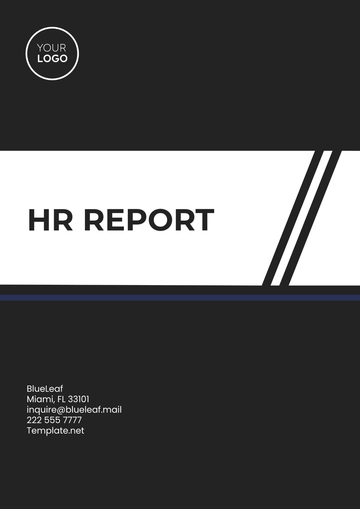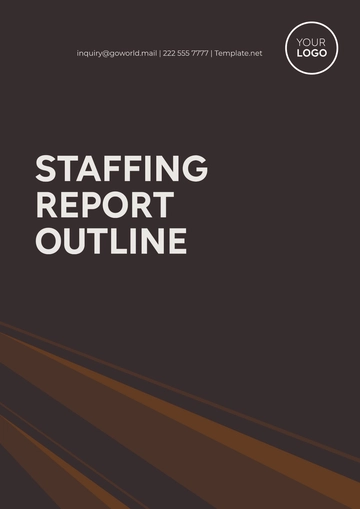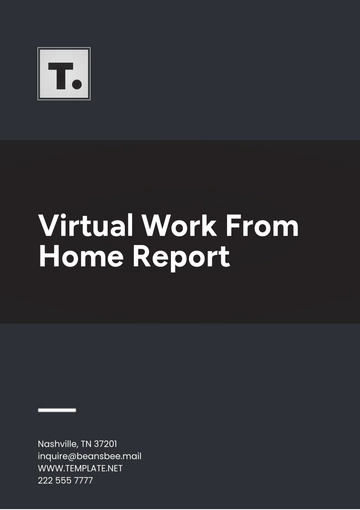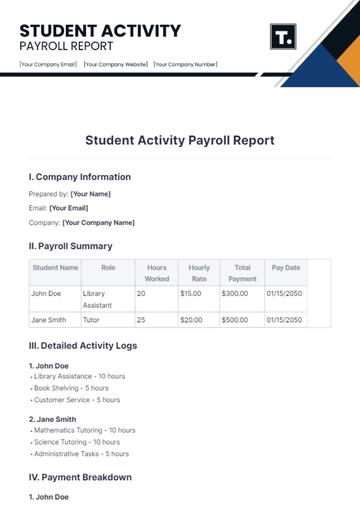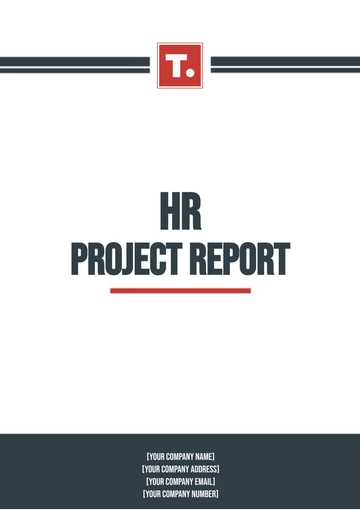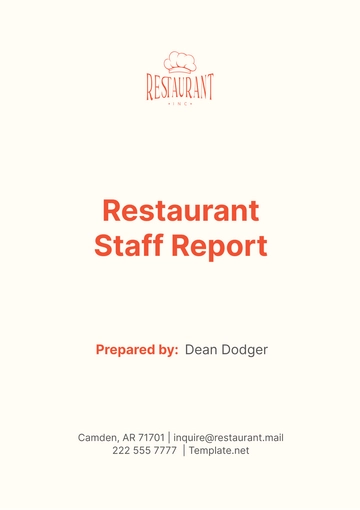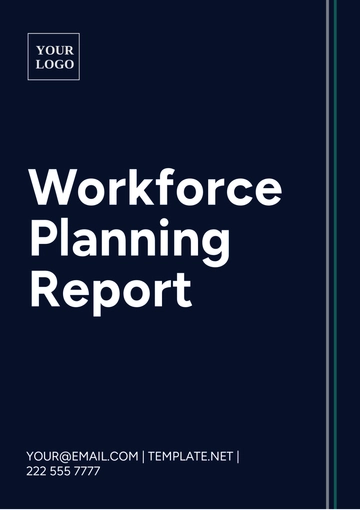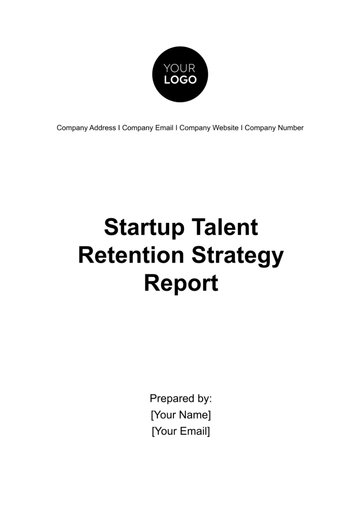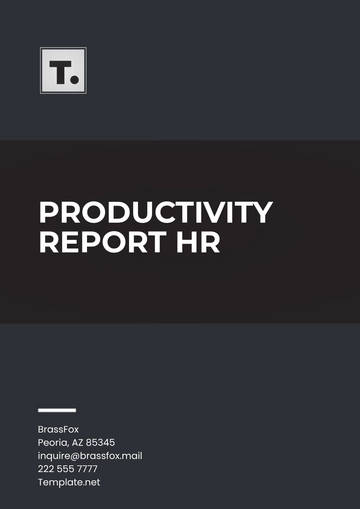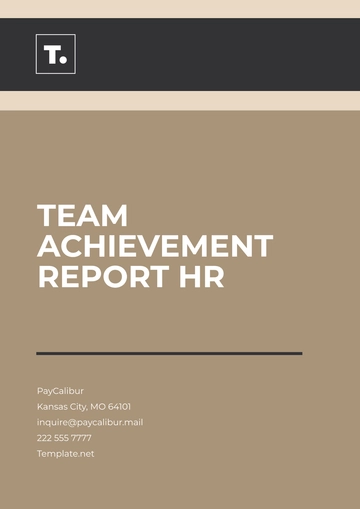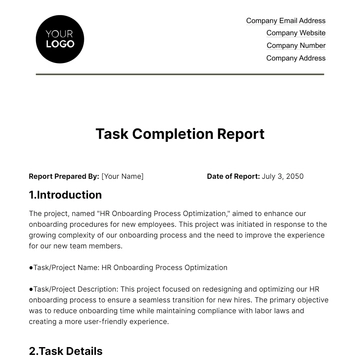Free Restaurant Staff Report
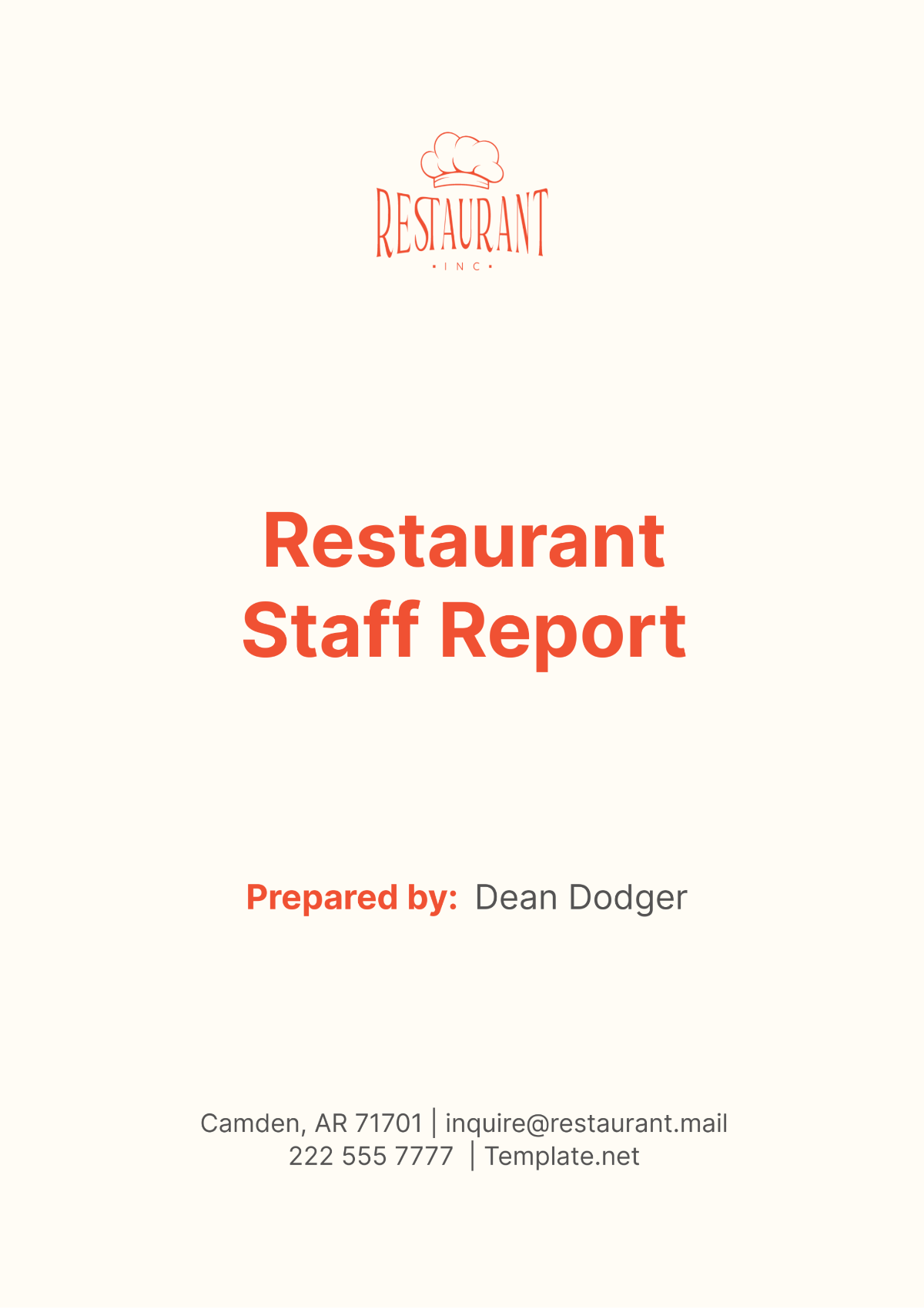
I. Introduction
This report provides a comprehensive analysis of the staffing structure at [YOUR COMPANY NAME]. It focuses on the distribution of roles, allocation of shifts, and the overall alignment of our human resources with our operational goals. Understanding the current staff makeup and their distribution across various shifts is pivotal for enhancing operational efficiency and ensuring top-tier service delivery to our patrons.
II. Staff Structure and Distribution
Overview of Staff Roles
The effectiveness of our restaurant operations heavily depends on the roles and responsibilities assigned to our staff. Each role is designed to contribute uniquely to the smooth running of our restaurant, from kitchen operations to customer service.
Table 1: Staff Role Distribution
Role | Number of Employees | Percentage of Total Staff |
|---|---|---|
Kitchen Staff | 20 | 40% |
Waitstaff | 15 | 30% |
Management | 5 | 10% |
Support Staff | 10 | 20% |
Analysis of Table 1: Table 1 provides an overview of our staff composition, highlighting a significant investment in kitchen and waitstaff personnel, which reflects our commitment to quality service and culinary excellence. The structure supports a robust operation capable of meeting diverse customer needs efficiently.
Staff Distribution by Shift
Effective shift management ensures that we have the right number of staff members at the right times, maximizing efficiency and maintaining service quality throughout different parts of the day.
Table 2: Shift Distribution
Shift | Number of Staff | Time of Day |
|---|---|---|
Morning | 15 | 6 AM - 2 PM |
Afternoon | 20 | 2 PM - 10 PM |
Night | 10 | 10 PM - 6 AM |
Analysis of Table 2: This table shows how our staffing is aligned with operational demands throughout the day. The higher number of staff during the afternoon reflects our preparation for the lunch rush and continued service through dinner, ensuring optimal customer service during peak dining hours.
III. Staff Performance and Productivity
Performance Metrics
Assessing staff performance is crucial for maintaining service quality. We utilize a range of metrics to evaluate how well our team meets the standards expected in our restaurant.
Table 3: Staff Performance Metrics
Metric | Average Score |
|---|---|
Customer Service | 4.5 / 5 |
Order Accuracy | 98% |
Operational Efficiency | 95% |
Analysis of Table 3: The metrics in Table 3 indicate a high level of customer service and operational efficiency, showcasing the effectiveness of our staff training and management systems. However, continuous monitoring and improvement are essential to maintain these standards and address any areas of weakness.
Productivity Analysis
Productivity metrics help us understand the efficiency of our staff, particularly in terms of how many customers each staff member can serve effectively during their shift.
Table 4: Productivity Metrics
Shift | Customers Served | Staff on Shift | Customers per Staff |
|---|---|---|---|
Morning | 100 | 15 | 6.67 |
Afternoon | 250 | 20 | 12.5 |
Night | 150 | 10 | 15 |
Analysis of Table 4: Table 4 reflects our staffing efficiency, particularly during the night shift where each staff member serves more customers. This indicates not only the capability of our night staff but also suggests that we may have the potential to handle increased customer volume during other shifts with similar efficiency.
IV. Staff Development and Training
Introduction to Training Initiatives
Ongoing staff development is crucial for maintaining high service standards and fostering a positive work environment. At [YOUR COMPANY NAME], we prioritize comprehensive training programs that are tailored to enhance both the skills and the satisfaction of our employees, from kitchen staff to management.
Training Programs Overview
Our training initiatives are structured to address various aspects of restaurant operations, including customer service, culinary skills, and management leadership.
Table 5: Training Initiatives Summary
Training Program | Participants | Focus Area |
|---|---|---|
Customer Service Excellence | All staff | Service skills, complaint handling |
Culinary Skills Enhancement | Kitchen staff | Cooking techniques, new recipes |
Leadership Development | Management | Leadership skills, conflict resolution |
Analysis of Table 5: This table outlines the primary focus areas of our training programs, designed to ensure that all team members are equipped with the latest skills and knowledge to perform their roles effectively. The Customer Service Excellence program, for instance, helps staff enhance interaction with customers, directly impacting guest satisfaction and return visits.
Impact of Training on Performance
We evaluate the effectiveness of our training by monitoring changes in performance metrics post-training. Improvement in customer service ratings and operational efficiency often reflects the successful implementation and uptake of training content.
Feedback and Adjustments
Regular feedback sessions post-training help us understand the efficacy of each program and make necessary adjustments. This iterative process ensures that our training remains relevant and beneficial to staff development and business goals.
V. Staff Engagement and Retention
Engagement Strategies
Employee engagement is a key driver of productivity and retention. We implement several strategies aimed at keeping our staff motivated and committed to the company.
Employee Satisfaction Survey Results
To gauge employee engagement and satisfaction, we conduct annual surveys that cover various aspects of the working environment.
Table 6: Employee Satisfaction Survey Results
Aspect | Satisfaction Rating |
|---|---|
Work Environment | 4.2 / 5 |
Compensation | 3.8 / 5 |
Job Security | 4.0 / 5 |
Career Advancement | 3.9 / 5 |
Analysis of Table 6: The ratings from our satisfaction survey indicate strong satisfaction with the work environment and job security. However, there is room for improvement in compensation and career advancement opportunities, highlighting areas where enhancements could boost overall staff morale and retention.
Retention Strategies
Our retention strategies focus on competitive compensation, opportunities for career advancement, and a positive work environment. Regular reviews of compensation structures and promotion pathways ensure that we remain an attractive employer within the industry.
Success of Retention Efforts
The effectiveness of our retention strategies is measured by our turnover rates and employee tenure. A lower-than-industry-average turnover rate indicates the success of our efforts and the satisfaction of our staff.
VI. Conclusion and Recommendations
Summary of Findings
This report highlights the strong structure and distribution of our staff, effective performance across shifts, and successful training initiatives. However, areas such as compensation and career advancement require further enhancement to improve staff satisfaction and retention rates.
Strategic Recommendations
Based on the insights gathered, we recommend the following strategies to improve our staffing and operational efficiency:
Enhance Compensation Packages: Review and adjust compensation packages to ensure they are competitive and commensurate with the responsibilities of each role. This should help improve satisfaction ratings related to pay.
Expand Training Programs: Introduce additional training modules focused on advanced culinary skills for kitchen staff and advanced customer service techniques for front-of-house staff. This could further improve our operational efficiency and customer service ratings.
Develop Clear Career Pathways: Formalize and communicate clear career advancement opportunities within the restaurant. This could involve creating new supervisory roles or offering cross-training in different departments to enhance career development.
Monitor and Adjust Shift Scheduling: Continue to analyze customer flow and staff efficiency to optimize shift scheduling. This may involve adjusting the number of staff during peak hours to ensure service quality without overstaffing.
Immediate Actions
Initiate a quarterly review of compensation and benefits to address the feedback regarding pay and career advancement.
Plan and launch a quarterly leadership training session for current and potential management staff to foster leadership skills across the restaurant.
Implement a new scheduling software that allows for more flexible and efficient staff shift planning based on predictive analysis of customer flow patterns.
By focusing on these strategic areas, [YOUR COMPANY NAME] can enhance its operational efficiency, improve staff satisfaction and retention, and ultimately deliver a superior dining experience to our customers. This holistic approach ensures our restaurant remains competitive and continues to thrive in a challenging industry.
- 100% Customizable, free editor
- Access 1 Million+ Templates, photo’s & graphics
- Download or share as a template
- Click and replace photos, graphics, text, backgrounds
- Resize, crop, AI write & more
- Access advanced editor
Streamline your restaurant's staffing with Template.net's Restaurant Staff Report Template. Efficiently track employee performance, attendance, and training progress with ease. With our AI editor tool, customize the template to align with your restaurant's specific needs and objectives seamlessly. Elevate your management processes and foster a productive work environment with Template.net.
You may also like
- Sales Report
- Daily Report
- Project Report
- Business Report
- Weekly Report
- Incident Report
- Annual Report
- Report Layout
- Report Design
- Progress Report
- Marketing Report
- Company Report
- Monthly Report
- Audit Report
- Status Report
- School Report
- Reports Hr
- Management Report
- Project Status Report
- Handover Report
- Health And Safety Report
- Restaurant Report
- Construction Report
- Research Report
- Evaluation Report
- Investigation Report
- Employee Report
- Advertising Report
- Weekly Status Report
- Project Management Report
- Finance Report
- Service Report
- Technical Report
- Meeting Report
- Quarterly Report
- Inspection Report
- Medical Report
- Test Report
- Summary Report
- Inventory Report
- Valuation Report
- Operations Report
- Payroll Report
- Training Report
- Job Report
- Case Report
- Performance Report
- Board Report
- Internal Audit Report
- Student Report
- Monthly Management Report
- Small Business Report
- Accident Report
- Call Center Report
- Activity Report
- IT and Software Report
- Internship Report
- Visit Report
- Product Report
- Book Report
- Property Report
- Recruitment Report
- University Report
- Event Report
- SEO Report
- Conference Report
- Narrative Report
- Nursing Home Report
- Preschool Report
- Call Report
- Customer Report
- Employee Incident Report
- Accomplishment Report
- Social Media Report
- Work From Home Report
- Security Report
- Damage Report
- Quality Report
- Internal Report
- Nurse Report
- Real Estate Report
- Hotel Report
- Equipment Report
- Credit Report
- Field Report
- Non Profit Report
- Maintenance Report
- News Report
- Survey Report
- Executive Report
- Law Firm Report
- Advertising Agency Report
- Interior Design Report
- Travel Agency Report
- Stock Report
- Salon Report
- Bug Report
- Workplace Report
- Action Report
- Investor Report
- Cleaning Services Report
- Consulting Report
- Freelancer Report
- Site Visit Report
- Trip Report
- Classroom Observation Report
- Vehicle Report
- Final Report
- Software Report
